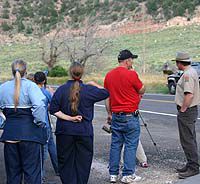| Brent Stettler of the Division of Wildlife Resources explains to tourists the importance of the bighorn sheep in Sunnyside. |
The Sunnyside bighorn sheep viewing turned out great for the Division of Wildlife Resources, bringing in a lot of tourist activity from as far away as Salt Lake City. But apparently the sheep weren’t told about the event, not being spotted by most watchers.
The bighorn sheep viewing was set for early in the morning and later in the evening on Saturday to ensure the best luck at spotting the sheep. But the Division of Wildlife Resources-sponsored bighorn sheep watch lacked one of the most important components, the bighorn sheep. No one could have expected the lack of sheep, which are usually spotted in the same spot in Sunnyside on a daily basis.
DWR biologists were available in the morning and in the evening on Saturday to help people locate the Rocky Mountain bighorns and answer questions. The DWR also provided binoculars and spotting scopes for those who didn’t have their own for the event.
Opportunities to view the Bighorn sheep population are nearly impossible in Utah due to their small numbers in the area.
Almost every year, a band of bighorn rams summer at the far east end of the town. The sheep near Sunnyside are part of the Nine Mile Bighorn Management Unit.
They typically forage on vegetation in the area, which is especially lush this year, and water at Grassy Trail Creek.
Their numbers usually vary between 10 and 25, although as many as 40 have been observed in past years.
As soon as monsoonal moisture arrives in August or September, the rams leave Sunnyside and return to the high plateaus overlooking the Green River.
This band of rams is accustomed to vehicles and people. This allows many tourists a chance to observe and photograph them at a relatively close distance.
One bighorn was eventually spotted on top of a small mountain in Sunnyside with the help of one watcher, but due to the distance was hard to see and nearly impossible to photograph.
The bighorns will still be around to watch until August or September and those who are interested can still visit the area next to Grassy Trail Creek where they usually are.
The DWR encourages interested parties to enjoy the bighorns, but also encourages the use of caution due to the extreme environmental stresses the animals are under.
Visitors are advised to avoid the mid-morning to late afternoon hours when the sheep bed down to escape the summer heat and become very difficult or impossible to see.
The DWR also asks that visitors observe them from a distance and avoid frightening them or preventing them from obtaining water.

